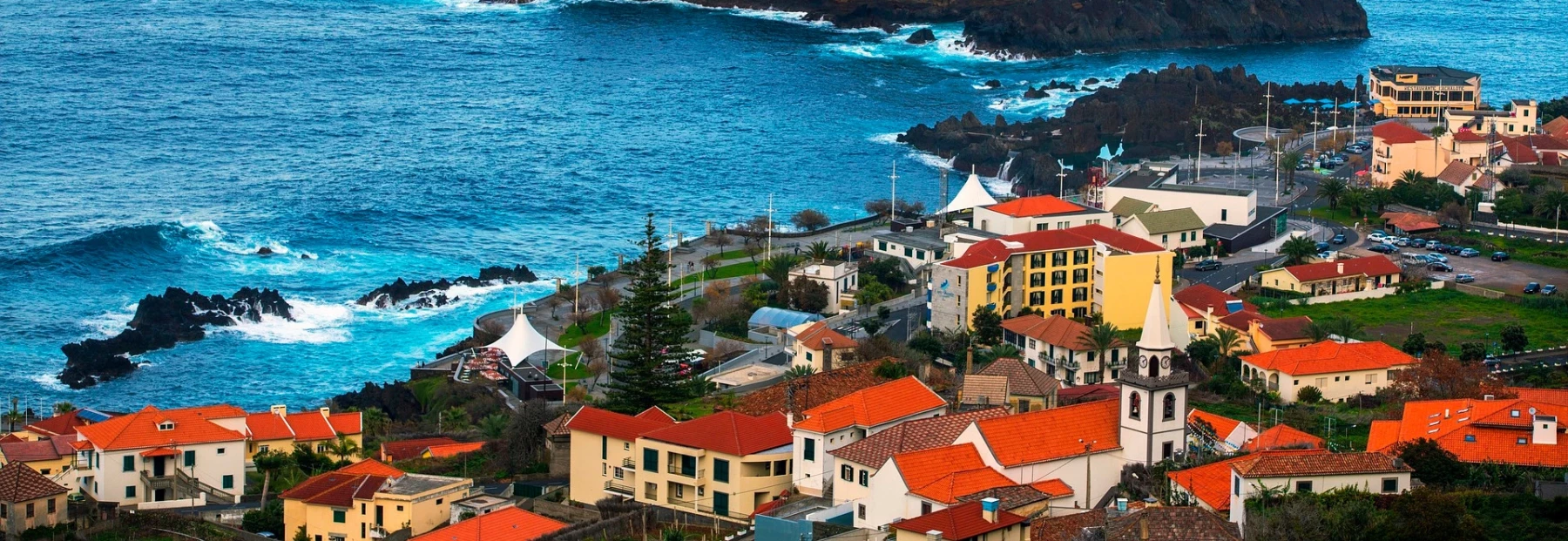Les 11 choses incontournables à faire à Madère
Dernière mise à jour : 26/05/2024 15:41Sommaire
- A visiter
-
- 1 - Funchal
- 2 - Jardins de Madère
- 3 - Curral das Freiras
- 4 - Pico do Arieiro et Pico Ruivo
- 5 - Levadas
- 6 - Cabo Girão
- 7 - les cascades de Rabaçal
- 8 - Porto Moniz
- 9 - Les Plages de Madère
- 10 - Ponta de São Lourenço
- 11 - Excursions vers Porto Santo
- Madère - Où Loger ?
- Madère - Comment se déplacer ?
- Madère - Meilleure période
Madère, souvent surnommée "l'île aux fleurs", est une destination de voyage extraordinaire située dans l'océan Atlantique, au large des côtes du Portugal. Voici quelques éléments clés qui pourraient constituer un thème de voyage sur cette île magnifique :
-
Nature exubérante : Madère est réputée pour sa beauté naturelle époustouflante, avec ses paysages variés allant des montagnes escarpées aux vallées luxuriantes. Les jardins botaniques, comme le Jardin Botanique de Funchal, offrent une incroyable diversité de plantes et de fleurs tropicales.
-
Randonnée pédestre : L'île est un paradis pour les randonneurs, avec des sentiers balisés qui traversent des forêts verdoyantes, des levadas (canaux d'irrigation) et des sommets montagneux offrant des vues spectaculaires sur l'océan.
-
Culture locale : Explorer la culture locale à travers sa musique, sa danse (comme le folklore traditionnel du "bailinho da Madeira"), son artisanat et sa cuisine est une expérience enrichissante. Ne manquez pas de goûter au célèbre vin de Madère et aux délices culinaires locaux comme l'espetada (brochette de viande) et le bolo do caco (pain traditionnel).
-
Aventures en plein air : Outre la randonnée, Madère offre une multitude d'activités en plein air, telles que le canyoning, le kayak de mer, la plongée sous-marine et même le surf sur certaines plages.
-
Histoire et patrimoine : Explorez les villes historiques comme Funchal, avec ses ruelles pavées, ses églises centenaires et ses bâtiments colorés. Ne manquez pas de visiter des sites historiques comme le Palais de São Lourenço et le Fort de São Tiago.
-
Observation de la faune marine : Les eaux chaudes et cristallines entourant Madère sont riches en vie marine, ce qui en fait un lieu idéal pour l'observation des baleines et des dauphins. Des excursions en bateau sont disponibles pour ceux qui souhaitent vivre cette expérience unique.
-
Détente et bien-être : Madère abrite également de luxueux spas et centres de bien-être, parfaits pour se détendre et se ressourcer après une journée d'aventures.
En résumé, un voyage à Madère promet une combinaison parfaite de nature, d'aventure, de culture et de détente, faisant de cette île une destination inoubliable pour les voyageurs en quête d'expériences authentiques et enrichissantes.
1 - Funchal
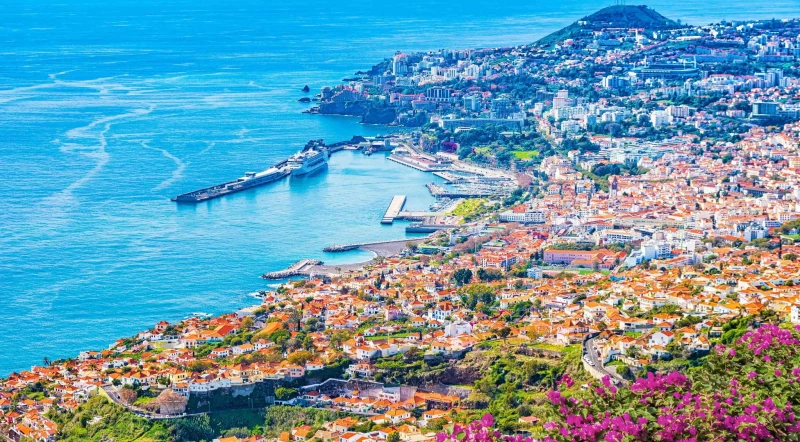
Funchal, capitale de l'île de Madère au Portugal, est une destination enchanteresse pour les voyageurs en quête d'aventure, de culture et de détente. Nichée entre des montagnes luxuriantes et l'océan Atlantique, Funchal offre un mélange captivant de paysages naturels époustouflants et d'attractions culturelles fascinantes.
À Funchal, les rues pavées étroites et sinueuses du centre-ville invitent à la découverte à pied, offrant des vues pittoresques sur les maisons colorées, les églises historiques et les jardins luxuriants. Les jardins botaniques de Funchal sont une oasis de tranquillité, abritant une multitude de plantes exotiques provenant des quatre coins du monde.
Les passionnés d'histoire peuvent explorer le riche patrimoine de Funchal en visitant des sites tels que le fort de São Tiago, qui offre une vue imprenable sur le port, et la cathédrale Sé, un magnifique exemple d'architecture gothique.
Pour les amateurs de sensations fortes, les activités ne manquent pas à Funchal. Des excursions en bateau pour observer les dauphins et les baleines dans leur habitat naturel, aux randonnées époustouflantes le long des levadas (anciens canaux d'irrigation), en passant par les descentes en toboggan traditionnel, il y en a pour tous les goûts.
La gastronomie de Funchal est également un incontournable, avec une cuisine délicieusement variée allant des plats de fruits de mer frais aux spécialités régionales telles que l'espetada (brochette de viande) et le bolo do caco (pain à l'ail). Les marchés locaux regorgent de produits frais et de produits artisanaux, offrant aux visiteurs l'occasion de goûter aux saveurs authentiques de Madère.
Que ce soit pour se détendre sur les plages de galets noirs volcaniques, s'aventurer dans les montagnes verdoyantes ou découvrir l'histoire et la culture fascinantes de la région, Funchal est une destination de voyage inoubliable qui saura captiver les cœurs et les esprits des voyageurs du monde entier.
 Nos astuces pour tirer le meilleur parti de votre expérience.
Nos astuces pour tirer le meilleur parti de votre expérience.
Visiter Funchal peut être une expérience fantastique, et voici quelques astuces pour en tirer le meilleur parti :
-
Explorer à pied: Funchal est une ville compacte et facile à explorer à pied. Promenez-vous dans les rues pavées du centre-ville pour découvrir les charmantes boutiques, les restaurants locaux et les sites historiques.
-
Prendre le téléphérique de Monte: Pour une vue panoramique imprenable sur Funchal et ses environs, prenez le téléphérique jusqu'au village de Monte. Assurez-vous de visiter l'église de Nossa Senhora do Monte et de descendre en luge traditionnelle jusqu'à Funchal.
-
Visiter les marchés: Ne manquez pas de visiter le marché des travailleurs (Mercado dos Lavradores) pour découvrir une variété de produits locaux, y compris des fruits tropicaux, du poisson frais et des fleurs exotiques.
-
Déguster la cuisine locale: Funchal regorge de restaurants proposant une cuisine délicieuse. Goûtez aux spécialités locales telles que l'espetada, le bolo do caco et le délicieux vin de Madère.
-
Faire une excursion en bateau: Partez en excursion en bateau pour observer les dauphins et les baleines dans leur habitat naturel ou pour explorer les criques isolées le long de la côte de Madère.
-
Assister à un spectacle culturel: Renseignez-vous sur les spectacles culturels locaux, tels que le folklore traditionnel ou les concerts de musique live, pour vivre une expérience authentique de la culture madérienne.
-
Planifier à l'avance pour les attractions populaires: Si vous prévoyez de visiter des attractions populaires comme le jardin tropical de Monte Palace ou le musée CR7 (dédié à Cristiano Ronaldo), il peut être judicieux de réserver vos billets à l'avance pour éviter les files d'attente.
-
Se déplacer en transport en commun: Funchal dispose d'un bon réseau de transports en commun, y compris des bus et des taxis. Utilisez ces options pour vous déplacer facilement dans la ville et ses environs.
-
S'imprégner de l'ambiance locale: Enfin, n'oubliez pas de vous imprégner de l'ambiance détendue et accueillante de Funchal en prenant le temps de vous asseoir dans un café en plein air, en admirant les vues sur l'océan et en profitant de la douce brise marine.
2 - Jardins de Madère
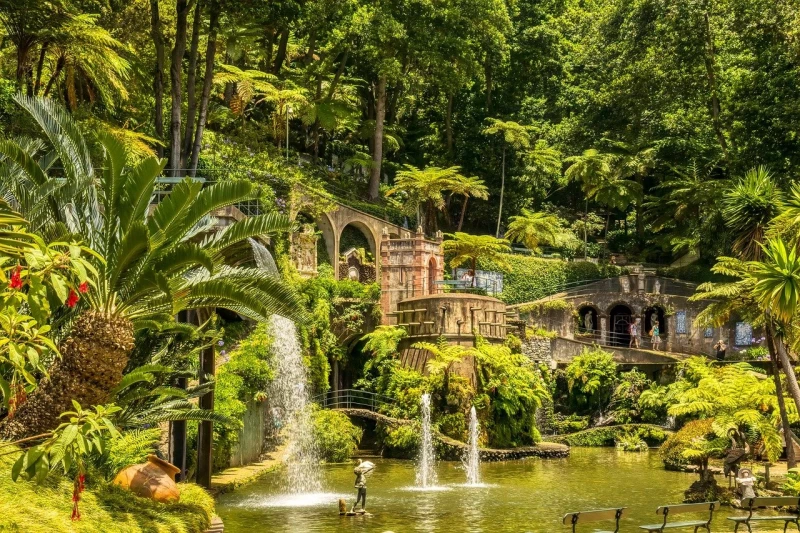
Les jardins de Madère sont célèbres pour leur beauté luxuriante et leur diversité botanique. L'île de Madère, un territoire portugais dans l'océan Atlantique, bénéficie d'un climat subtropical idéal pour une grande variété de plantes. Voici quelques-uns des jardins les plus renommés de Madère :
-
Jardin botanique de Madère : Situé dans la capitale, Funchal, ce jardin offre une vaste collection de plantes indigènes et exotiques. Avec une grande superficie et des sentiers bien entretenus, les visiteurs peuvent explorer une grande diversité d'espèces botaniques.
-
Jardins do Palheiro : Situés aux abords de Funchal, ces jardins présentent un mélange charmant de plantes ornementales, d'arbres fruitiers et de vues imprenables sur le paysage environnant.
-
Jardins du Palais Monte : Niché au sommet d'une colline à Monte, ce jardin est réputé pour son atmosphère tranquille et sa collection de plantes exotiques du monde entier. Il abrite également une galerie d'art et une exposition de carreaux de faïence portugais.
-
Jardin tropical du Palais Monte : Un autre jardin situé à Monte, celui-ci se distingue par sa collection de plantes tropicales, ses étangs décoratifs et ses vues panoramiques sur la ville de Funchal.
-
Jardin d'orchidées : Spécialisé dans les orchidées, ce jardin est un paradis pour les amoureux de ces fleurs élégantes. Situé à São Gonçalo, près de Funchal, le jardin abrite une grande variété d'espèces d'orchidées du monde entier.
Ce ne sont là que quelques exemples des beaux jardins que l'on peut trouver sur l'île de Madère, chacun offrant une expérience unique pour les visiteurs qui souhaitent apprécier la nature luxuriante de la région.
 Nos astuces pour tirer le meilleur parti de votre expérience.
Nos astuces pour tirer le meilleur parti de votre expérience.
Visiter les jardins de Madère peut être une expérience très enrichissante et agréable. Voici quelques astuces pour profiter au maximum de votre visite :
-
Planifiez votre visite à l'avance : Renseignez-vous sur les différents jardins disponibles sur l'île et choisissez ceux qui vous intéressent le plus. Faites attention aux horaires d'ouverture et aux jours de fermeture.
-
Choisissez le bon moment de la journée : Les matinées ou les fins d'après-midi peuvent être les moments les plus agréables pour visiter les jardins, car il fait généralement plus frais et moins bondé. Essayez d'éviter les heures de pointe pour une expérience plus paisible.
-
Portez des vêtements confortables et appropriés : Étant donné que vous allez marcher beaucoup, portez des chaussures confortables et des vêtements adaptés au climat, comme un chapeau et de la crème solaire.
-
Apportez de l'eau et des collations : Il est important de rester hydraté, surtout par temps chaud. Emportez une bouteille d'eau réutilisable et des collations légères pour recharger vos batteries pendant votre visite.
-
Prenez votre temps pour explorer : Ne vous précipitez pas à travers les jardins. Prenez le temps d'admirer les plantes, de prendre des photos et de profiter de la beauté naturelle qui vous entoure.
-
Renseignez-vous sur la flore locale : Si vous êtes passionné par la botanique, renseignez-vous à l'avance sur les différentes espèces de plantes que vous pourriez rencontrer dans les jardins. Cela rendra votre visite encore plus enrichissante.
-
Profitez des vues panoramiques : De nombreux jardins de Madère offrent des vues spectaculaires sur l'océan ou sur les paysages environnants. Ne manquez pas l'occasion de vous arrêter et d'admirer ces panoramas à couper le souffle.
-
Respectez l'environnement : Veillez à respecter les règles et les indications des jardins, comme ne pas marcher sur les plantes ou ramasser des fleurs. Contribuez à préserver la beauté naturelle des lieux pour les générations futures.
En suivant ces conseils, vous êtes sûrs de passer un moment mémorable à explorer les magnifiques jardins de Madère.
3 - Curral das Freiras
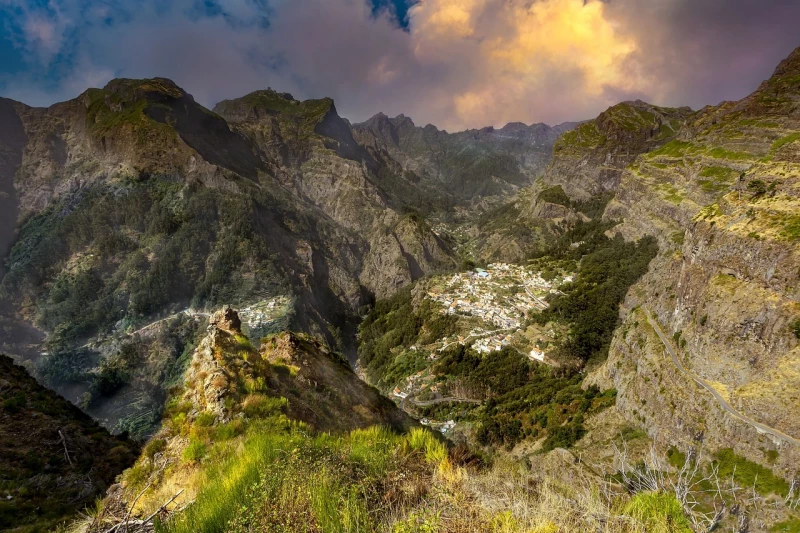
Curral das Freiras, également connu sous le nom de "Vallée des Nonnes", est un village pittoresque situé sur l'île de Madère, au Portugal. Niché au cœur de l'île, il est entouré de montagnes imposantes, dont le Pico do Arieiro et le Pico Ruivo, les plus hauts sommets de Madère.
Le nom du village, "Curral das Freiras", qui se traduit par "Vallée des Nonnes", trouve son origine dans un événement historique. Selon la légende, au XVIe siècle, des religieuses du couvent de Santa Clara à Funchal ont cherché refuge dans la vallée pour échapper aux attaques de pirates. Impresssées par l'isolement et la sécurité de la région, elles l'ont comparée à un "curral" ou "corral", semblable à un abri pour le bétail. Au fil du temps, le nom est resté, et le village est devenu connu sous le nom de Curral das Freiras.
Aujourd'hui, Curral das Freiras est une destination touristique populaire réputée pour ses paysages magnifiques, sa végétation luxuriante et son atmosphère tranquille. Les visiteurs peuvent profiter des sentiers de randonnée offrant des vues à couper le souffle sur les montagnes et les vallées environnantes, explorer les rues charmantes du village bordées de maisons traditionnelles et déguster des spécialités locales telles que les châtaignes et la liqueur de châtaigne, qui sont des spécialités de la région.
Le village est également célèbre pour son festival annuel de la châtaigne, qui a lieu en novembre, célébrant la saison des récoltes avec de la musique, de la danse et, bien sûr, de nombreux plats délicieux à base de châtaignes.
Dans l'ensemble, Curral das Freiras offre une retraite paisible au milieu de la beauté naturelle de Madère, ce qui en fait une destination incontournable pour les voyageurs en quête de détente et d'aventure.
 Nos astuces pour tirer le meilleur parti de votre expérience.
Nos astuces pour tirer le meilleur parti de votre expérience.
Si vous prévoyez de visiter Curral das Freiras, voici quelques astuces pour profiter pleinement de votre séjour :
-
Choisissez le bon moment : Les mois d'avril à septembre sont généralement les meilleurs pour visiter Curral das Freiras en raison des conditions météorologiques plus clémentes. Cependant, si vous souhaitez éviter les foules, envisagez de voyager en dehors de la haute saison touristique.
-
Prévoyez suffisamment de temps : Bien que Curral das Freiras soit un petit village, il y a beaucoup à voir dans les environs, notamment les sentiers de randonnée, les points de vue panoramiques et les attractions locales. Prévoyez au moins une journée complète pour explorer la région.
-
Emportez des vêtements appropriés : Étant donné que Curral das Freiras est situé en montagne, les températures peuvent être plus fraîches que sur la côte. Assurez-vous d'emporter des vêtements chauds, surtout si vous prévoyez de faire de la randonnée ou de passer du temps à l'extérieur.
-
Explorez les sentiers de randonnée : La région environnante offre de superbes sentiers de randonnée offrant des vues spectaculaires sur les montagnes et les vallées. Assurez-vous d'apporter de bonnes chaussures de marche et de l'eau, et renseignez-vous sur les différents sentiers disponibles à l'Office du tourisme local.
-
Dégustez les spécialités locales : Ne manquez pas de goûter aux spécialités culinaires de la région, telles que les châtaignes et la liqueur de châtaigne. Vous pouvez les trouver dans les restaurants locaux ou lors du festival annuel de la châtaigne en novembre.
-
Prenez votre temps pour explorer le village : Flânez dans les rues pittoresques du village, admirez les maisons traditionnelles en pierre et découvrez l'histoire et la culture locales.
-
Capturez des souvenirs : Assurez-vous d'apporter votre appareil photo pour capturer les paysages magnifiques et les moments mémorables de votre visite à Curral das Freiras.
En suivant ces astuces, vous pourrez profiter pleinement de votre visite à Curral das Freiras et découvrir tout ce que cette charmante région a à offrir.
4 - Pico do Arieiro et Pico Ruivo
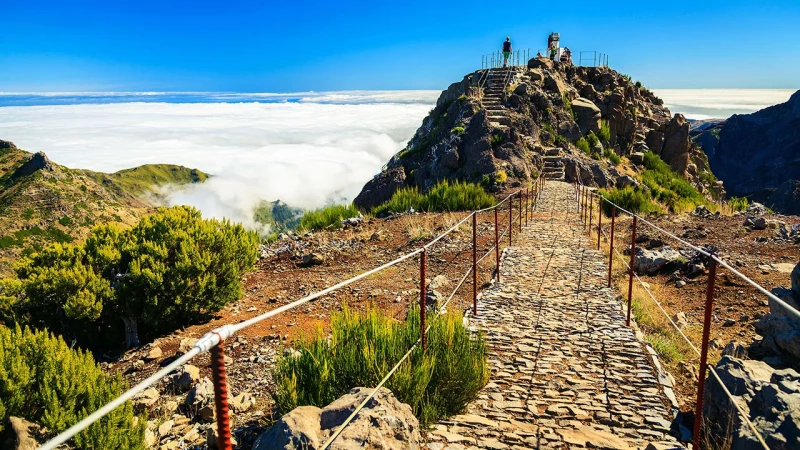
Le Pico do Arieiro et le Pico Ruivo sont deux des sommets les plus emblématiques de l'île de Madère, située dans l'océan Atlantique, appartenant au Portugal.
-
Pico do Arieiro : Avec une altitude d'environ 1 818 mètres, le Pico do Arieiro est le troisième plus haut sommet de l'île de Madère. Il offre des vues spectaculaires sur les montagnes environnantes, ainsi que sur l'océan Atlantique par temps clair. Il est accessible par la route depuis Funchal, la capitale de Madère, ce qui en fait un lieu touristique populaire. De là, les visiteurs peuvent emprunter des sentiers de randonnée pour explorer davantage la région, y compris la possibilité de se rendre au sommet du Pico Ruivo.
-
Pico Ruivo : Avec une altitude d'environ 1 862 mètres, le Pico Ruivo est le plus haut sommet de Madère. Il est accessible à pied à partir du Pico do Arieiro par un sentier de randonnée bien entretenu. La randonnée offre des vues spectaculaires sur les montagnes environnantes et sur l'océan Atlantique. Le sommet du Pico Ruivo est souvent enveloppé de nuages, créant une atmosphère mystique. Il y a aussi un petit refuge au sommet pour les randonneurs qui souhaitent passer la nuit.
Ces deux sommets offrent des expériences de randonnée inoubliables et sont des destinations populaires pour les amoureux de la nature et les amateurs de plein air visitant l'île de Madère.
 Nos astuces pour tirer le meilleur parti de votre expérience.
Nos astuces pour tirer le meilleur parti de votre expérience.
Voici quelques astuces pour visiter le Pico do Arieiro et le Pico Ruivo :
-
Préparez-vous physiquement : Les randonnées jusqu'au Pico do Arieiro et au Pico Ruivo peuvent être exigeantes, surtout si vous prévoyez de faire l'ascension jusqu'au sommet du Pico Ruivo. Assurez-vous d'être en bonne forme physique et de porter des chaussures de randonnée confortables.
-
Consultez les conditions météorologiques : Les conditions météorologiques peuvent changer rapidement en montagne, surtout sur les sommets exposés comme le Pico Ruivo. Vérifiez les prévisions météorologiques avant de partir et soyez prêt à reporter votre visite si le temps est mauvais.
-
Apportez suffisamment d'eau et de nourriture : Il peut être difficile de trouver de l'eau et de la nourriture en cours de route, surtout si vous faites une randonnée plus longue. Assurez-vous d'apporter suffisamment d'eau et de collations pour votre randonnée.
-
Commencez tôt : Pour éviter la chaleur de la journée et les foules, il est recommandé de commencer votre randonnée tôt le matin. Cela vous permettra également d'avoir plus de temps pour profiter des vues une fois que vous atteignez les sommets.
-
Portez des vêtements appropriés : Même s'il fait chaud en bas, les températures peuvent être fraîches en altitude, surtout sur le Pico Ruivo. Assurez-vous d'apporter des couches supplémentaires et un coupe-vent pour vous protéger du vent.
-
Respectez l'environnement : Lors de votre visite, veillez à ne laisser aucune trace derrière vous. Respectez les sentiers balisés et les règles de conservation de l'environnement pour préserver ces magnifiques paysages naturels pour les générations futures.
En suivant ces astuces, vous serez bien préparé pour profiter pleinement de votre visite au Pico do Arieiro et au Pico Ruivo.
5 - Levadas
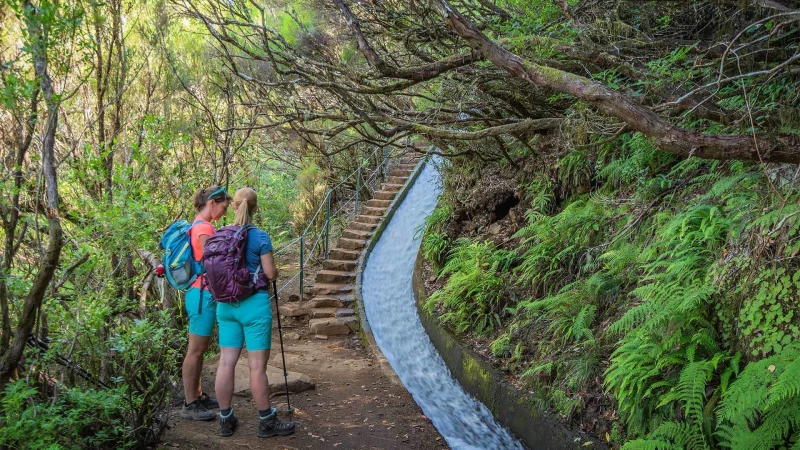
Les levadas sont une caractéristique unique de l'île portugaise de Madère. Ce sont des canaux d'irrigation étroits initialement construits pour distribuer l'eau des régions les plus humides de l'île vers les zones plus sèches à des fins agricoles. Le relief accidenté de Madère a rendu nécessaire la construction de ces levadas, qui traversent souvent des montagnes escarpées et des falaises.
Aujourd'hui, ces levadas servent non seulement à leur objectif initial, mais elles offrent également certains des sentiers de randonnée les plus populaires de Madère. Randonner le long des levadas permet aux visiteurs d'explorer les paysages luxuriants de l'île, y compris les forêts, les cascades et les points de vue spectaculaires. Certains chemins de levada sont relativement faciles et adaptés à tous les randonneurs, tandis que d'autres sont plus difficiles et nécessitent une bonne condition physique et le courage de grimper en hauteur.
Les levadas ne sont pas seulement un exploit d'ingénierie pratique, mais aussi un symbole culturel de Madère, illustrant la capacité de l'île à s'adapter à son environnement naturel et l'ingéniosité de son peuple. Elles sont devenues une partie essentielle de l'industrie touristique de l'île, attirant des visiteurs du monde entier qui viennent découvrir la beauté unique et la tranquillité de la campagne madérienne.
 Nos astuces pour tirer le meilleur parti de votre expérience.
Nos astuces pour tirer le meilleur parti de votre expérience.
Lors de la visite des levadas à Madère, voici quelques astuces utiles :
-
Choisissez les bonnes randonnées : Il existe de nombreux sentiers de levadas à Madère, certains plus faciles et d'autres plus difficiles. Assurez-vous de choisir celui qui correspond à votre niveau de forme physique et à vos capacités.
-
Portez des chaussures appropriées : Les sentiers peuvent être glissants, surtout par temps humide. Des chaussures de randonnée robustes avec une bonne adhérence sont recommandées pour éviter les chutes.
-
Apportez suffisamment d'eau et de nourriture : Même si les randonnées peuvent être relativement courtes, il est essentiel d'avoir suffisamment d'eau, surtout par temps chaud. Apportez également des collations pour recharger vos batteries en cours de route.
-
Protégez-vous du soleil : Même si une partie des sentiers passe à travers des forêts ombragées, il est important de se protéger du soleil avec un chapeau, des lunettes de soleil et de la crème solaire, surtout si vous randonnez pendant les heures les plus chaudes de la journée.
-
Soyez conscient des conditions météorologiques : Les conditions météorologiques peuvent changer rapidement à Madère, surtout en montagne. Vérifiez les prévisions météorologiques avant de partir en randonnée et soyez prêt à faire demi-tour si les conditions se détériorent.
-
Respectez l'environnement : Madère est une réserve naturelle magnifique et fragile. Assurez-vous de laisser les sentiers propres en emportant vos déchets avec vous et en respectant la flore et la faune locales.
-
Informez quelqu'un de votre itinéraire : Avant de partir en randonnée, informez un proche ou le personnel de votre hébergement de votre itinéraire prévu, surtout si vous randonnez seul. Cela peut être utile en cas d'urgence.
En suivant ces conseils, vous pouvez profiter pleinement de votre expérience de randonnée le long des levadas à Madère tout en restant en sécurité et en préservant l'environnement.
6 - Cabo Girão
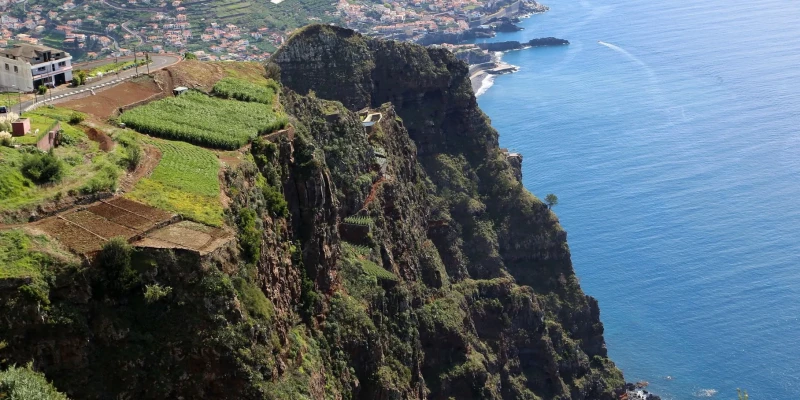
Cabo Girão est une magnifique falaise maritime située sur l'île portugaise de Madère, dans l'océan Atlantique. C'est l'une des falaises océaniques les plus hautes d'Europe, s'élevant à environ 580 mètres au-dessus du niveau de la mer. Les vues depuis Cabo Girão sont à couper le souffle, offrant des panoramas de la côte environnante, de l'océan Atlantique et du relief accidenté de Madère.
En plus de sa beauté naturelle, Cabo Girão est devenu une attraction touristique populaire, attirant des visiteurs qui viennent admirer le paysage spectaculaire et profiter des vues panoramiques depuis la plateforme d'observation en verre qui s'étend au-dessus du bord de la falaise. La plateforme transparente offre une expérience exaltante, permettant aux visiteurs de regarder droit vers la mer en contrebas.
Cabo Girão est également un endroit prisé pour les activités de plein air telles que la randonnée et l'escalade, bien que les visiteurs doivent faire preuve de prudence en raison des falaises escarpées et des conditions météorologiques imprévisibles. Dans l'ensemble, c'est une destination incontournable pour quiconque explore l'île de Madère.
7 - les cascades de Rabaçal
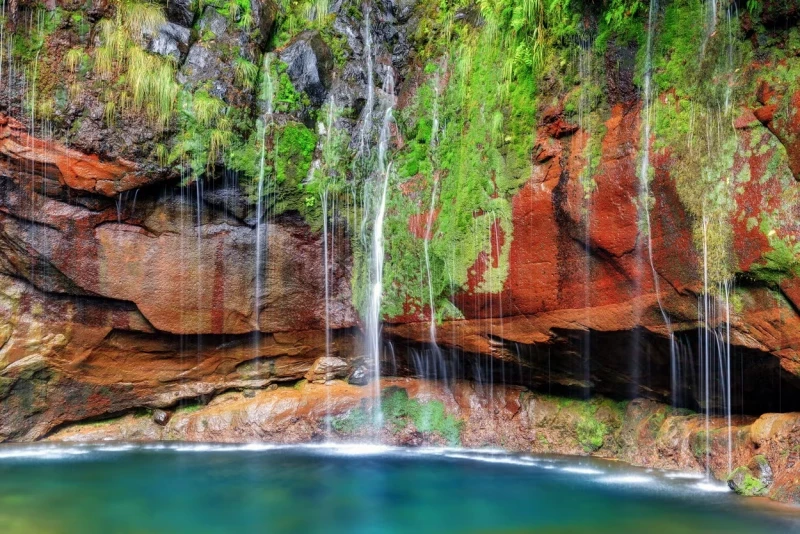
Les cascades de Rabaçal sont un ensemble de cascades situées sur l'île de Madère, au Portugal. Elles sont nichées dans la vallée de Rabaçal, une région connue pour sa végétation luxuriante et ses paysages spectaculaires. Les cascades de Rabaçal sont célèbres pour leur beauté naturelle et constituent une attraction populaire pour les randonneurs et les amoureux de la nature.
Parmi les cascades les plus connues de Rabaçal, on trouve la cascade du Risco, qui est la plus haute de l'île avec une chute d'eau impressionnante de plus de 100 mètres. À proximité se trouve également la cascade des 25 Fontes, ainsi nommée pour les multiples sources qui alimentent ses eaux. Cette cascade forme une série de petits bassins et de piscines naturelles, créant un paysage enchanteur.
Pour atteindre les cascades de Rabaçal, les visiteurs peuvent emprunter des sentiers de randonnée bien balisés qui offrent également des vues panoramiques sur la région environnante. La région de Rabaçal est réputée pour sa biodiversité, abritant une flore et une faune diversifiées, ce qui en fait un lieu privilégié pour les amateurs de photographie et d'observation de la nature.
En résumé, les cascades de Rabaçal sont un trésor naturel de l'île de Madère, offrant aux visiteurs une expérience inoubliable au cœur d'une nature préservée et magnifique.
 Nos astuces pour tirer le meilleur parti de votre expérience.
Nos astuces pour tirer le meilleur parti de votre expérience.
Si vous envisagez de visiter les cascades de Rabaçal, voici quelques astuces pour rendre votre expérience plus agréable :
-
Choisissez le bon moment de l'année : Les cascades de Rabaçal sont généralement les plus impressionnantes après de fortes pluies, donc planifiez votre visite pendant la saison des pluies ou juste après pour voir les cascades dans leur splendeur maximale.
-
Préparez-vous pour la randonnée : Les cascades de Rabaçal sont accessibles via des sentiers de randonnée. Assurez-vous d'avoir des chaussures de randonnée confortables, de l'eau, des collations et une protection solaire, car vous marcherez sur un terrain varié et parfois escarpé.
-
Vérifiez les conditions des sentiers : Avant de partir, assurez-vous de vérifier les conditions des sentiers, surtout s'il a plu récemment. Certaines parties des sentiers peuvent devenir glissantes, alors soyez prudent et équipez-vous en conséquence.
-
Arrivez tôt : Les cascades de Rabaçal peuvent devenir assez fréquentées, surtout pendant les heures de pointe. Pour éviter la foule et profiter pleinement de la beauté naturelle, essayez d'arriver tôt le matin.
-
Respectez la nature : Pendant votre visite, veillez à respecter l'environnement naturel en suivant les règles du parc et en évitant de laisser des déchets derrière vous. Laissez les cascades aussi belles que vous les avez trouvées pour que d'autres visiteurs puissent en profiter également.
-
Explorez les environs : En plus des cascades principales, il y a beaucoup à voir dans la région de Rabaçal, y compris des levadas (canaux d'irrigation) et une végétation luxuriante. Prenez le temps d'explorer les environs et de découvrir toutes les merveilles naturelles que cette région a à offrir.
En suivant ces astuces, vous pourrez profiter pleinement de votre visite aux cascades de Rabaçal et créer des souvenirs inoubliables dans ce magnifique coin de Madère.
8 - Porto Moniz
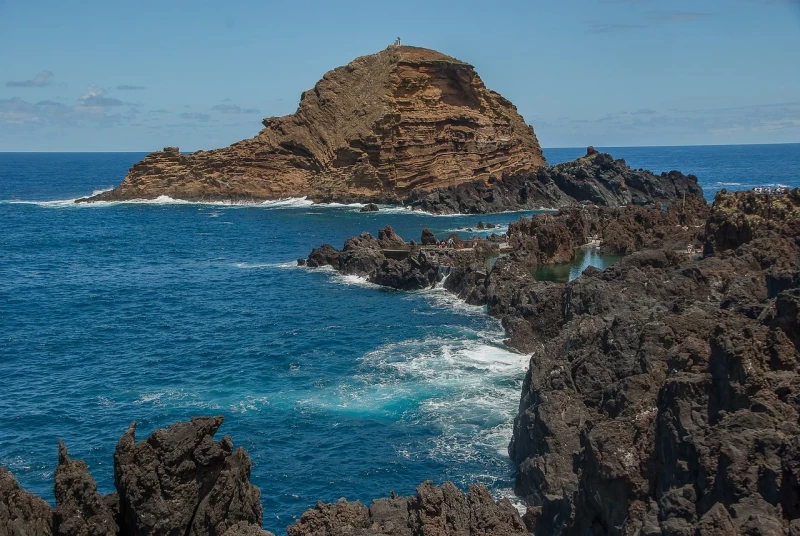
Porto Moniz est une pittoresque paroisse civile située sur la côte nord-ouest de l'île de Madère, au Portugal. Elle est célèbre pour ses paysages naturels époustouflants, comprenant des falaises impressionnantes, une végétation luxuriante et des piscines naturelles en roche volcanique qui attirent des visiteurs du monde entier. La caractéristique la plus emblématique de Porto Moniz est ses piscines naturelles, formées par la lave volcanique et remplies d'eau de mer cristalline. Ces piscines offrent aux visiteurs la possibilité de nager dans un environnement sûr et magnifique, entouré d'un paysage à couper le souffle. De plus, Porto Moniz est réputé pour son ambiance de village charmante, avec des maisons traditionnelles, des restaurants proposant des fruits de mer frais et un rythme de vie détendu qui en fait une destination idéale pour ceux qui recherchent la tranquillité et la beauté naturelle.
9 - Les Plages de Madère
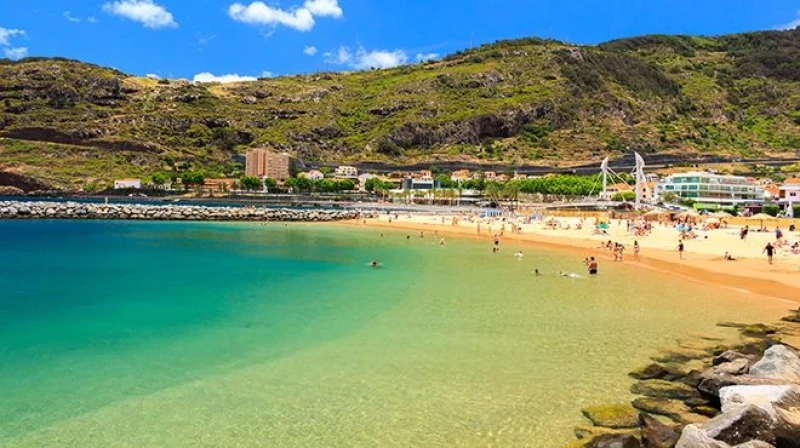
Madère est célèbre pour ses paysages montagneux et ses falaises abruptes, ce qui signifie qu'elle n'a pas de plages de sable traditionnelles comme on peut les trouver dans d'autres destinations balnéaires. Cependant, l'île offre des alternatives uniques et charmantes pour les amoureux de la mer. Voici quelques-unes des options disponibles :
-
Praia Formosa : Bien que ce ne soit pas une plage de sable, Praia Formosa est la plus grande plage publique de Funchal, la capitale de Madère. Elle est principalement constituée de galets et offre une vue magnifique sur l'océan Atlantique.
-
Calheta : Calheta, sur la côte sud-ouest de Madère, possède une plage artificielle de sable doré importé. La plage est entourée de jardins et offre des conditions de baignade plus calmes grâce à son port artificiel.
-
Praia do Garajau : Une petite plage située près de Funchal, Praia do Garajau est une crique rocheuse populaire pour la plongée en apnée. Les eaux claires offrent une visibilité impressionnante pour explorer la vie marine.
-
Ponta Gorda : Il s'agit d'une zone de baignade complexe avec deux piscines d'eau de mer, des terrains de sport, des espaces verts et des promenades. L'endroit est fréquenté par les habitants et les touristes.
-
Porto Santo : Bien que techniquement une île différente, Porto Santo, qui fait partie de l'archipel de Madère, possède de magnifiques plages de sable fin qui s'étendent sur neuf kilomètres. On peut y accéder en ferry depuis Funchal.
Bien que Madère ne soit pas connue pour ses plages de sable, elle compense largement par ses paysages spectaculaires, ses piscines naturelles et ses criques pittoresques qui offrent des expériences uniques en bord de mer.
10 - Ponta de São Lourenço

Ponta de São Lourenço est une péninsule spectaculaire située à l'extrémité est de l'île de Madère, au Portugal. Cette région est renommée pour son paysage unique et saisissant, caractérisé par des falaises abruptes, des formations rocheuses volcaniques et une végétation colorée.
Les points forts de Ponta de São Lourenço incluent :
-
Sentiers de randonnée pittoresques : La péninsule est parcourue par des sentiers de randonnée bien entretenus offrant des vues époustouflantes sur l'océan Atlantique et le paysage environnant. Les sentiers conduisent les visiteurs à travers des terrains variés, des zones arides et rocheuses aux paysages plus luxuriants et verts.
-
Flore et faune uniques : Malgré ses conditions relativement arides, Ponta de São Lourenço abrite une variété d'espèces végétales et animales adaptées à l'environnement difficile. On peut y rencontrer une flore unique, telle que des plantes succulentes, et des oiseaux marins qui nichent le long des falaises.
-
Casa do Sardinha : Casa do Sardinha est une petite maison située sur la péninsule, offrant des informations sur la flore locale, la faune et les caractéristiques géologiques. Elle sert de centre éducatif et de point d'intérêt pour les visiteurs.
-
Vue sur les Îles Désertes : Par temps clair, les visiteurs peuvent profiter de vues panoramiques sur les Îles Désertes voisines depuis Ponta de São Lourenço.
-
Cactus et cheminées de fées : Le paysage est parsemé de cactus et d'autres plantes résistantes, créant un contraste visuel unique avec le bleu profond de l'océan Atlantique. Les cheminées de fées et les formations rocheuses naturelles ajoutent à la beauté pittoresque.
Ponta de São Lourenço est une destination prisée des amateurs de nature et de randonnée cherchant une expérience différente des zones plus boisées et montagneuses de Madère. Les sentiers et les points de vue en font un excellent endroit pour explorer la beauté naturelle diversifiée de l'île.
11 - Excursions vers Porto Santo
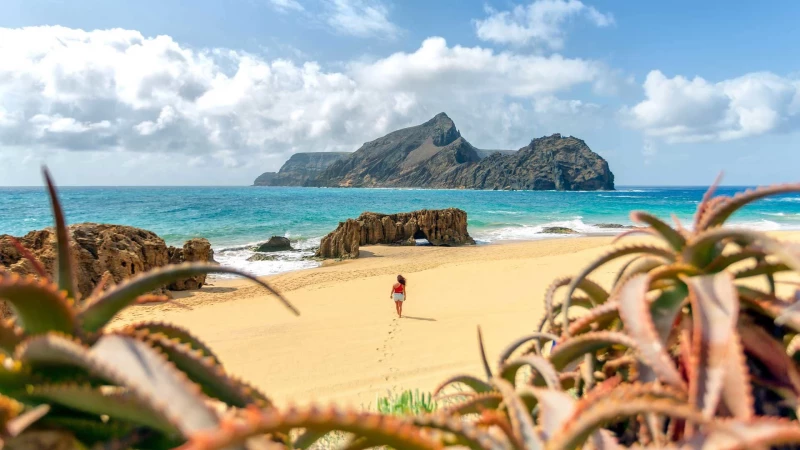
Pour se rendre de Madère à Porto Santo, vous pouvez opter pour différentes options de transport, notamment le ferry et l'avion.
-
Ferry : Il existe des liaisons régulières en ferry entre Funchal, la capitale de Madère, et Porto Santo. Les trajets en ferry offrent une traversée agréable sur l'océan Atlantique, et la durée du voyage est d'environ 2 heures. Les horaires peuvent varier en fonction de la saison, alors il est recommandé de vérifier les horaires et de réserver à l'avance.
-
Avion : Vous pouvez également prendre un vol de Funchal à Porto Santo. L'aéroport de Porto Santo est bien desservi par des vols réguliers depuis l'aéroport de Madère. La durée du vol est courte, d'environ 15 à 20 minutes. Cela peut être une option pratique pour ceux qui préfèrent un voyage plus rapide.
Il est conseillé de vérifier les horaires des ferries ou des vols et de réserver à l'avance, surtout pendant les périodes de forte affluence touristique. Les horaires peuvent également être soumis à des changements en fonction des conditions météorologiques, il est donc bon de rester informé.
Porto Santo, bien que faisant partie de l'archipel de Madère, offre une expérience différente avec ses vastes plages de sable doré et son ambiance plus détendue. Que vous choisissiez le ferry ou l'avion, les deux moyens de transport offrent des options pour explorer cette charmante île voisine.
 Nos astuces pour tirer le meilleur parti de votre expérience.
Nos astuces pour tirer le meilleur parti de votre expérience.
Visiter Porto Santo peut être une expérience enrichissante avec ses magnifiques plages de sable doré et son atmosphère décontractée. Voici quelques astuces pour tirer le meilleur parti de votre séjour à Porto Santo :
-
Profiter des Plages : Les plages de Porto Santo sont l'une des principales attractions. La plage principale s'étend sur neuf kilomètres, offrant un cadre idyllique pour se détendre et se baigner. Assurez-vous de prendre le temps d'explorer différentes parties de la plage.
-
Randonnée à Pico do Castelo : Pour une vue panoramique de l'île, envisagez de faire une randonnée jusqu'au Pico do Castelo. C'est le point culminant de Porto Santo, offrant une vue imprenable sur l'île et l'océan.
-
Explorer la Ville de Vila Baleira : Vila Baleira est la principale ville de Porto Santo. Promenez-vous dans ses rues pittoresques, visitez la Maison-Musée de Christophe Colomb (Casa Museu Cristóvão Colombo) et découvrez l'histoire de l'île.
-
Essayer la Gastronomie Locale : Goûtez aux plats locaux de Porto Santo. Les fruits de mer et les plats traditionnels de l'île font partie de l'expérience culinaire. Ne manquez pas de déguster le "Bolo de Caco," un pain rond typique de Madère.
-
Activités Nautiques : Profitez des activités nautiques disponibles, telles que la plongée, le snorkeling, et le kayak. Les eaux claires et calmes autour de l'île offrent d'excellentes opportunités pour explorer la vie marine.
-
Découvrir la Réserve Naturelle : Visitez la Réserve Naturelle de Ponta da Calheta, qui abrite une diversité de faune et de flore. Vous pourriez y rencontrer des oiseaux migrateurs et découvrir des espèces endémiques.
-
Location de Vélo ou de Scooter : Explorez l'île de manière flexible en louant un vélo ou un scooter. Cela vous permettra de découvrir des endroits moins accessibles en voiture.
-
Prendre en Compte les Horaires des Transports : Si vous voyagez depuis Madère, assurez-vous de prendre en compte les horaires des ferries ou des vols pour optimiser votre temps à Porto Santo.
-
Ambiance Décontractée : Profitez de l'ambiance décontractée de l'île. Porto Santo est moins développé sur le plan touristique que Madeira, offrant une atmosphère plus paisible et authentique.
-
Observer le Coucher de Soleil : Terminez vos journées en beauté en observant le coucher de soleil sur la plage. Les plages de Porto Santo offrent souvent des vues spectaculaires au crépuscule.
En suivant ces astuces, vous pourrez pleinement apprécier la beauté naturelle et l'atmosphère relaxante de Porto Santo.
Madère - Où Loger ?
À Madère, vous trouverez une multitude d'options d'hébergement adaptées à différents budgets et préférences. Voici quelques suggestions sur les endroits où séjourner sur l'île :
-
Funchal : La capitale de l'île offre une large gamme d'hébergements, des hôtels de luxe aux maisons d'hôtes plus modestes. Vous trouverez également de nombreux appartements et locations de vacances dans le centre-ville ainsi que le long de la côte, offrant une vue magnifique sur l'océan.
-
Zones côtières populaires : Des villes et villages côtiers tels que Caniço, Ponta do Sol, Calheta et Machico proposent également des hébergements variés, souvent à proximité des plages et offrant un accès facile à des activités comme la plongée, le surf et la voile.
-
Montagnes et zones rurales : Pour une expérience plus paisible et proche de la nature, envisagez de séjourner dans les régions montagneuses de l'île, comme São Vicente, Santana ou Paul da Serra. Vous y trouverez des hébergements rustiques, des maisons d'hôtes et des auberges offrant des vues spectaculaires sur les paysages montagneux et les levadas.
-
Hébergement traditionnel : Madère propose également des maisons de campagne restaurées, appelées "quintas", qui offrent une expérience d'hébergement traditionnelle avec un charme rustique et une hospitalité chaleureuse.
-
Resorts tout compris : Si vous préférez un séjour plus tout compris, certains resorts de luxe offrent des installations haut de gamme telles que des piscines, des spas, des restaurants gastronomiques et des activités de loisirs sur place.
Quel que soit votre choix, assurez-vous de réserver à l'avance, surtout pendant la haute saison touristique, pour garantir la disponibilité et profiter au maximum de votre séjour à Madère.
Madère - Comment se déplacer ?
À Madère, il existe plusieurs options pour se déplacer sur l'île, en fonction de vos préférences et de votre itinéraire. Voici quelques-unes des principales options de transport disponibles :
-
Voiture de location : La location de voiture est l'une des options les plus populaires pour explorer l'île de manière indépendante. Les routes de Madère sont bien entretenues et offrent des vues spectaculaires, mais certaines routes de montagne peuvent être étroites et sinueuses, donc soyez prudent si vous n'êtes pas habitué à conduire dans de telles conditions.
-
Bus publics : Madère dispose d'un réseau de bus publics reliant les principales villes et villages de l'île. Les bus sont généralement fiables et offrent un moyen économique de se déplacer. Les horaires peuvent varier en fonction des jours de la semaine et des saisons, alors assurez-vous de vérifier les horaires à l'avance.
-
Taxis : Les taxis sont largement disponibles à Madère, en particulier dans les zones touristiques comme Funchal. Vous pouvez héler un taxi dans la rue ou en trouver aux stations de taxis désignées. Assurez-vous de convenir du prix avec le chauffeur avant de monter à bord, car les tarifs peuvent varier.
-
Téléphériques et téléphériques : Pour des vues panoramiques spectaculaires sur l'île, vous pouvez utiliser les téléphériques et les téléphériques, notamment le téléphérique de Funchal qui monte jusqu'au Monte et le téléphérique de Achadas da Cruz à Porto Moniz.
-
Visites guidées et excursions : Si vous préférez explorer l'île avec un guide local, de nombreuses agences proposent des visites guidées et des excursions en groupe couvrant divers sites touristiques et activités.
-
Marche à pied : Madère est également un endroit idéal pour la randonnée, avec des sentiers balisés qui traversent des paysages magnifiques, des levadas pittoresques et des villages charmants. Assurez-vous de porter des chaussures de randonnée appropriées et de vous renseigner sur les itinéraires avant de partir en randonnée.
Quelle que soit l'option de transport que vous choisissez, vous aurez l'occasion de découvrir la beauté naturelle et la richesse culturelle de Madère tout en vous déplaçant dans l'île.
Madère - Meilleure période
La meilleure période pour visiter Madère dépend de vos préférences en matière de climat et d'activités. Voici un aperçu des saisons et des conditions météorologiques sur l'île :
-
Printemps (mars à mai) :
- Le printemps est une période agréable pour visiter Madère, avec des températures douces et des fleurs en pleine floraison dans les jardins botaniques et à travers l'île.
- C'est également une période idéale pour la randonnée, car les températures ne sont pas encore trop chaudes et les sentiers ne sont pas aussi fréquentés qu'en été.
-
Été (juin à août) :
- L'été est la haute saison touristique à Madère, avec des températures chaudes et ensoleillées, idéales pour les activités de plage, de baignade et de sports nautiques.
- Les festivals et les événements culturels sont également fréquents pendant cette période.
-
Automne (septembre à novembre) :
- L'automne est une autre période populaire pour visiter Madère, avec des températures agréables et des paysages colorés alors que les feuilles commencent à changer de couleur.
- C'est également la saison des vendanges, et vous pouvez goûter au vin de Madère fraîchement pressé lors de visites dans les vignobles locaux.
-
Hiver (décembre à février) :
- L'hiver à Madère est doux et généralement ensoleillé, ce qui en fait une destination populaire pour les vacanciers cherchant à fuir le froid de l'Europe continentale.
- Les fêtes de fin d'année, y compris les marchés de Noël et les célébrations du Nouvel An, ajoutent à l'attrait de l'île pendant cette période.
En résumé, Madère est une destination attrayante tout au long de l'année, mais le printemps et l'automne peuvent être considérés comme les meilleures saisons pour éviter les foules tout en profitant de conditions météorologiques agréables. Si vous préférez la chaleur estivale et les activités balnéaires, alors l'été peut être le moment idéal pour visiter.
